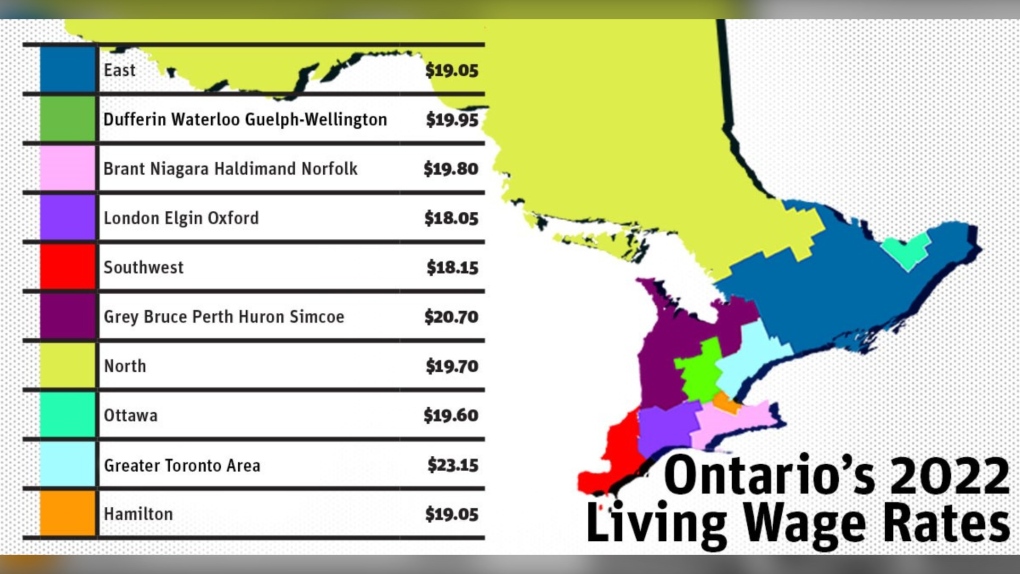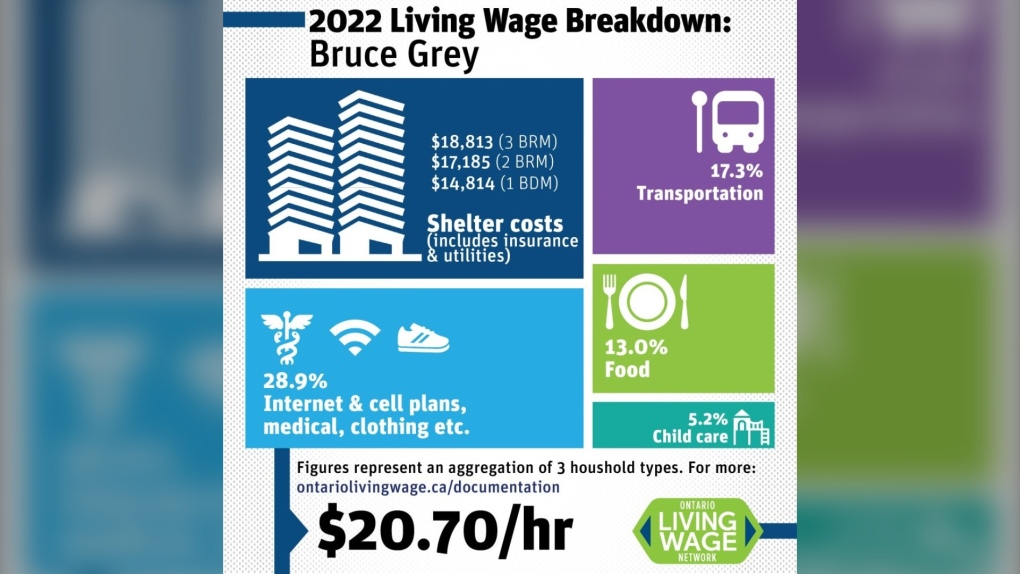Rural Ontario 'living wage' rivals Toronto
It’s supposed to be cheaper to live in rural Ontario, but the most recent calculations from the Ontario Living Wage Network suggest otherwise.
“We’ve known for quite a few months that people are facing real challenges out there. The situation is getting really dire,” said Francesca Dobbyn, executive director of the United Way of Bruce-Grey, who helped calculate this year’s living wage for Grey-Bruce.
Dobbyn says it takes a wage of $20.70/hour for an average worker in Grey-Bruce to make ends meet each month. That’s a whopping 12.6 per cent increase over last year, thanks in large part to the increasing cost of housing and food.
“What scares me about these numbers is that we did these calculations in the summer. Food costs have gone up since then, the inflationary pressures are apparent, so this means this is kind of the bottom. This is not something to attain, this is the place to start and go up from,” explained Dobbyn.
 A graphic depicting the living wage needed to live in different geographical areas across Southern Ontario. (Source: Ontario Living Wage Network)
A graphic depicting the living wage needed to live in different geographical areas across Southern Ontario. (Source: Ontario Living Wage Network)
Huron-Perth’s living wage is the same $20.70/hour, putting Grey-Bruce and Huron-Perth behind only Toronto’s $23.15/hour living wage, as the top two highest living wages in Ontario. These figures are much more than the $18.05/hr living wage in London-Elgin-Oxford, according to the Ontario Living Wage Network.
Dobbyn says the lack of public transportation, requiring two cars for two working people plays a role in driving up rural residents’ costs.
“You can go to a farm gate and get some cheap vegetables, especially at this time of year, but that’s not on an ongoing basis. Utility costs, like furnace oil and propane are higher, because not everyone has access to natural gas, plus the low standard of housing here makes everything in rural life that much more expensive,” said Dobbyn.
 An average wage of $20.70 an hour is needed for the average worker in Grey-Bruce to make ends meet each month. (Source: Ontario Living Wage Network)
An average wage of $20.70 an hour is needed for the average worker in Grey-Bruce to make ends meet each month. (Source: Ontario Living Wage Network)
“The living wage reflects the realities of living in a community much better than a minimum wage does. For workers in our region, if they’re relying on a job paying minimum wage, a person would be short about $728 per month as far as covering expenses. That’s a huge gap, and why the living wage is so important,” explained Kristin Crane, social research and planning coordinator with the United Way of Perth-Huron.
While there are more “living wage” employers than ever before in Midwestern Ontario, $20.70/hr makes it a lot more difficult for small businesses to join the club.
“The province would save money if they supported small businesses who achieved a living wage,” said Dobbyn.
To see the provincial breakdown and how much the living wage is in your region, you can visit the Ontario Living Wage Network website.
CTVNews.ca Top Stories

WATCH Woman, 50, critically injured in explosive Ottawa crash caught on camera, police looking for witnesses
Dashcam footage sent to CTV News shows a vehicle travelling at a high rate of speed in the wrong direction before striking and damaging a hydro pole.
Maserati driver seriously injures 2 in Surrey hit-and-run: police
The driver of a Maserati fled the scene of a crash in Surrey that left two people seriously injured Saturday night, according to authorities.
The FBI says the man responsible for New Year's truck attack visited New Orleans twice before
The man responsible for the truck attack in New Orleans on New Year's Day that killed 14 people visited the city twice before and recorded video of the French Quarter with hands-free glasses, an FBI official said Sunday.
Here’s why you should monitor your blood pressure, keep it in check
An Ottawa pharmacist says blood pressure is a good indicator of overall health, noting the importance of keeping it at healthy rates.
Heaviest snowfall in a decade possible in some areas as winter storm threatens U.S.
A blast of snow, ice, wind and plunging temperatures stirred up dangerous travel conditions in parts of the central U.S. on Sunday, as a disruptive winter storm brought the possibility of the 'heaviest snowfall in a decade' to some areas.
'It keeps you up at night': Effects of postal strike linger into 2025, business owners say
The Canada Post strike ended last month, but the disruption continues to harm businesses at the start of the new year.
Air Canada passengers living with extra baggage fees
Some Air Canada passengers at Montreal’s Trudeau Airport were annoyed that they will now have to pay additional fees for their carry-on luggage.
Russia 'getting what it deserves,' Ukraine says, after launching counterattack in border region
Ukraine has launched a counterattack in the southern Russian border region of Kursk, warning that Russia is 'getting what it deserves.'
Britain wants to get close to Trump. Will Elon Musk stand in the way?
It was not the start to 2025 that Keir Starmer wanted or expected: in the early hours of New Year’s Day, Elon Musk lobbed a series of angry posts and allegations towards the British prime minister, engulfing his government in a very public fight.
































